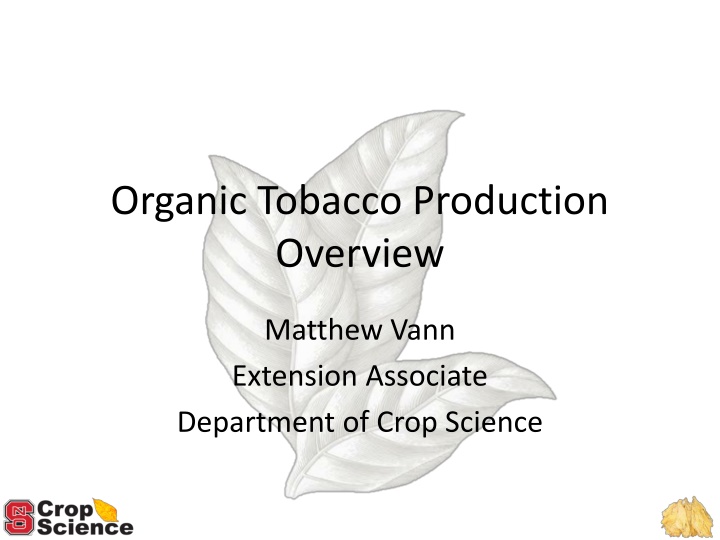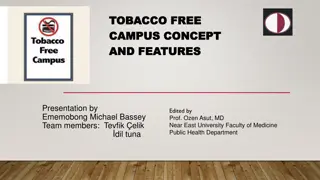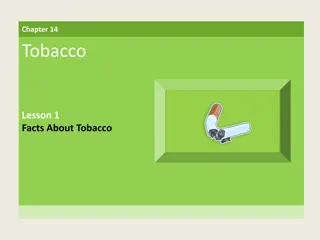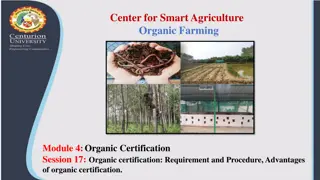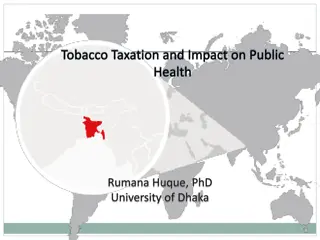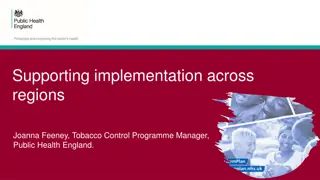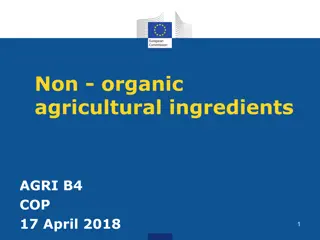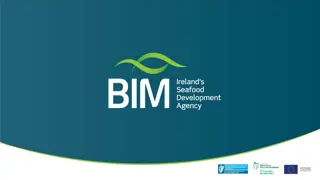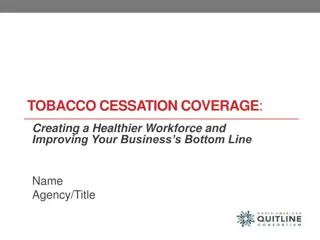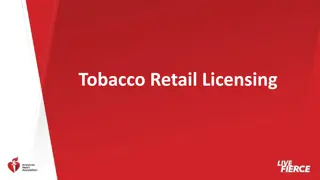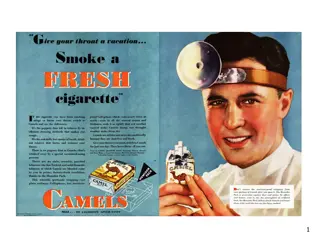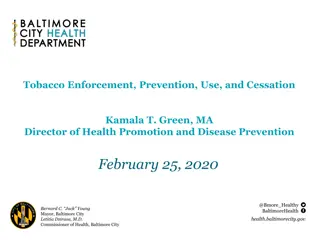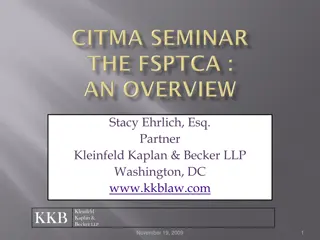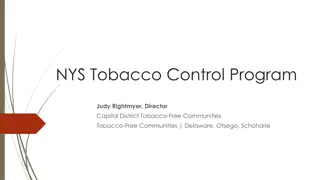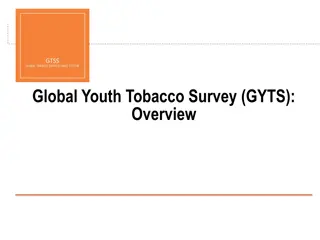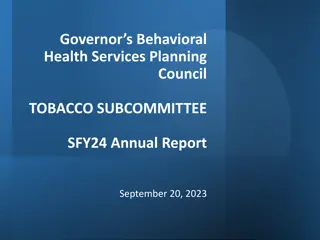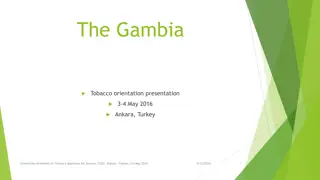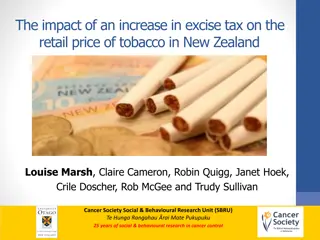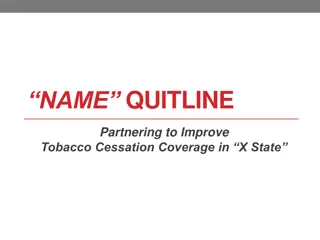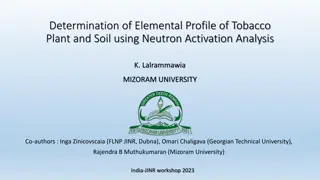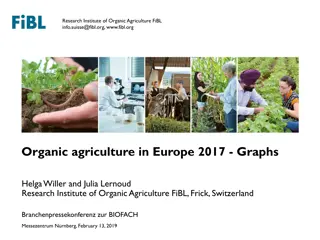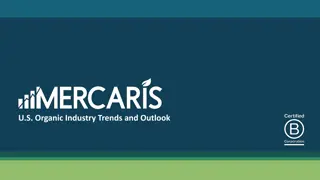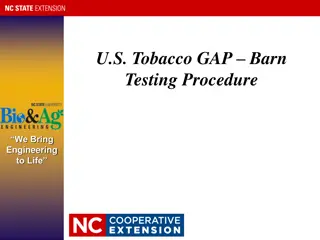Guide to Organic Tobacco Production Process
Understand the process of organic tobacco production including obtaining a contract, certifying land, inspections, maintaining certification, selling leaf, and transitioning from conventional to organic production. Get insights on organic certification through USDA-National Organic Program, required steps, and maintaining certification to avoid losing it. Contact information for contracting and stepwise plan for certification provided. Plan ahead for the 6-12 month certification process to ensure compliance.
Download Presentation

Please find below an Image/Link to download the presentation.
The content on the website is provided AS IS for your information and personal use only. It may not be sold, licensed, or shared on other websites without obtaining consent from the author.If you encounter any issues during the download, it is possible that the publisher has removed the file from their server.
You are allowed to download the files provided on this website for personal or commercial use, subject to the condition that they are used lawfully. All files are the property of their respective owners.
The content on the website is provided AS IS for your information and personal use only. It may not be sold, licensed, or shared on other websites without obtaining consent from the author.
E N D
Presentation Transcript
Organic Tobacco Production Overview Matthew Vann Extension Associate Department of Crop Science
Organic Production Process Grow, sell, repeat... Obtain a Contract Not that simple Certify Land Inspection Maintain Certification Inspection Sell Leaf Inspection Defined order to the process
Contact Information for Contracting Before taking a SINGLE step, call someone! Getting a contract obligation is step #1!! RJR: Robbie Parker 919-810-0581 RJR: Ron Wright 336-829-9200 SFNTC: Randal Ball 919-692-3120
Organic Certification Organic certification is through the USDA- National Organic Program (NOP). Third parties perform inspections & certifications. Example: Quality Certification Services Certification service group must offer NOP AND EU certification Crop Consultants are available to help with certification. Most certification services have contact information
Organic Certification In general, the certification process can take 6- 12 months. Depending on the time of year and farming situation Plan ahead! Extensive paperwork must be filed before certified leaf can be sold
Organic Certification: Transition from Conventional to Organic Production Certification requires three consecutive years of no synthetic material application. SFNTC can purchase leaf as Pesticide Residue Clean during the transition Leaf must be produced with organic practices Certification service will assist
Stepwise Plan 1. Contact a certification group/request application forms. 2. Develop organic system plan 3. Certifier initial review/desk audit 4. Onsite inspection 5. Final review
Maintaining Organic Certification Use of non-approved products is the easiest way to lose certification. Use of synthetic materials will result in a three year re-certification process Annual inspection by a certification service is required. More paperwork.....
Overview of Production Requirements Must have organic certification Maintain accurate/up-to-date records Do not use synthetic materials Do not use prohibited natural products Just because something is labeled as natural/organic does not mean it is approved Check with your buying company and certification service before trying something new Must have crop nutrient management plan Use organically certified seed/transplants Must have defined boundaries between organic and conventional fields. Buffer zones= 50 feet
Overview of Production Requirements Irrigation ponds must be protected from non- organic run-off Organic leaf must be cured in organic only barns. Cannot mix organic and non-organic leaf during curing Separate baling and storage Separate spraying equipment
List of Approved Products Fertilizer: Nature Safe 13-0-0 Allganic K 0-0-51 Natural Lime High Calcium Limestone Dolomitic Limestone Worm Castings Sulfate of Potash Pest Control: Dipel DF Entrust?? Sucker Control: O-Tac (fatty alcohol) Greenhouse: Sunshine Natural Mix Seed: Cross Creek Seed
List of Products NOT Approved Materials from GMO s Synthetic Chemicals Bio-solids/Sewage Sludge Ash from burning Sodium Nitrate Bulldog Soda Non-organic seeds & transplants
Material Consideration Use only approved products. If there are questions contact your leaf purchaser & your certification service! The list of natural and organic products is very long, but most materials have not been evaluated for tobacco production Many issues will be avoided if you maintain open communication with the above groups.
Agronomic Considerations: Greenhouse Seabird guano is approved for use. Stem Length (cm/plant) Usable Transplants (%) Fertilizer 2002 2003 2002 2003 Similar management approach. Temperature, seeding rate, clipping, etc. 16-5-16 8.7 5 73 88 Bat Manure (8-4-1) 2.6 1 0 0 Seabird Guano (13-8-2) 6.8 3 77 72 Bat Manure (3x rate) -- 3 -- 84
Agronomic Considerations: Fertility Nature Safe 13-0-0 Nutri-max 12-1-0
Agronomic Considerations: N Fertility Apply nitrogen materials at conventional material rates. i.e., if you have traditionally targeted 60 lbs. N/acre, shoot for that with these materials Any application method is acceptable. Broadcast prior to transplanting, side-dress, or a combination. Realize that N is in organic form and has to convert to ammonium or nitrate for plant use. No immediate green up
Agronomic Considerations: Weed Control No organically approved herbicides. Increased reliance on cultivation and hand weeding. Best option is to choose fields with low weed pressure and rotate crops. Use cover crops to suppress weed growth
Summary Organic production is a long term concept. Approach it with that in mind Contact RJR or SFNTC before doing anything else. Contact a certification group in a timely fashion. Crop management is different.
